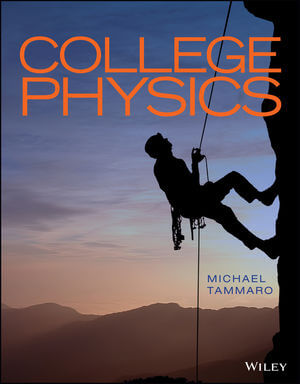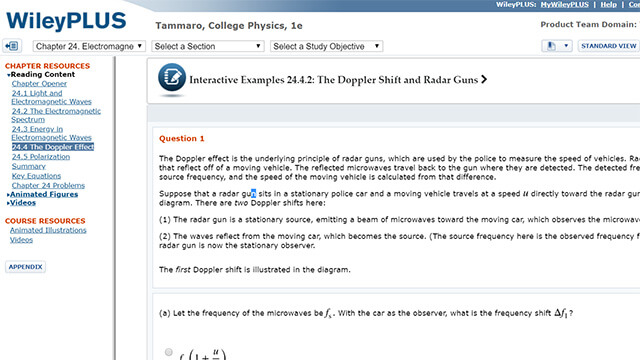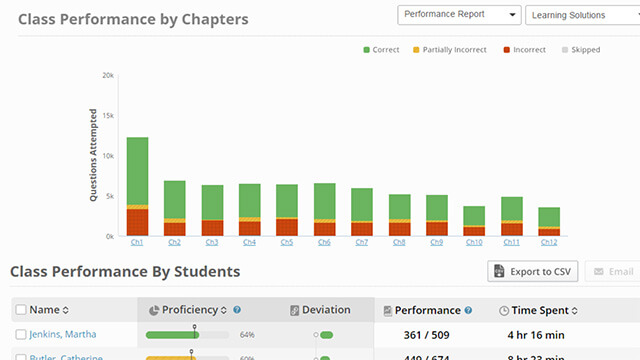
College Physics, 1st Edition
By Michael Tammaro
College Physics transforms students from passive to active learners through a unique presentation of material built from the ground up in a digital environment. Research has proven that students achieve a greater depth of understanding when active learning is used in the classroom and in assignments. College Physics engages students in a cadence of read- interact-reinforce through an interactive learning experience. This interactive learning design in WileyPLUS helps student do more than memorize content, and the rigor of the questions provides relevance to the reading and allows the students to form relationships around the content.
WileyPLUS for College Physics includes Adaptive Practice to help students build proficiency on topics and use their study time more effectively.
Schedule a Demo Sign Up for a Test Drive Adopt WileyPLUSWant to learn more about WileyPLUS? Click Here

Interactive Exercises
This WileyPLUS course has been modularized to engage students in a virtual discourse of learning 24/7. Small chunks of content presented in reading or video format are followed by guided student verification points that offer feedback to ensure comprehension. These embedded verification points consist of three question types: concept checks, practice problems, and interactive examples. All assigned reading questions will report directly into the gradebook.
Animated Illustrations and Visuals
The visual elements engage all types of learners. Each course section within WileyPLUS contains assignable animated illustrations and videos to illustrate concepts and provide demonstrations, allowing students to visualize the science of motion.

Adaptive Practice
Every student has a different starting point, and adaptive practice provides endless opportunities for practice to effectively prepare for class or quizzes and exams. Active retrieval of information with practice questions is proven to improve retention of information better than re-reading or reviewing the material, and students who use adaptive practice to prepare for exams do significantly better than those who do not. Students begin with a quick, section-level diagnostic to determine their initial level of understanding, and they can use the dashboard and quick reports to see what topics they know and don’t know.
Michael Tammaro is a teaching professor of physics at the University of Rhode Island. He received his Ph.D. in 1997 from Iowa State University where he studied statistical and computational physics. He has taught the full range of undergraduate physics courses but began teaching general physics in 2002 to gain the experience necessary to write a text for the algebra-based physics market.
Tammaro teaches both small and large lectures and engages students with in-class demonstrations, videos, animations, and recitation-style group work. He is passionate about teaching physics and is always looking for better ways to engage and encourage students. His work with thousands of students over thousands of contact hours has given him detailed knowledge of the specific conceptual and mathematical difficulties faced by students taking algebra-based physics. This experience is reflected in every detail of his innovative course, College Physics.
When he is not teaching or creating innovative resources, Tammaro spends much of his time practicing classical guitar and restoring his 40-foot classic yawl.
0 Mathematical Preliminaries 1
0.1 Mathematics 2
0.2 Algebra 3
0.3 Using Your Calculator 13
0.4 Geometry and Trigonometry 17
0.5 Graphs 21
1 Introduction to Physics 27
1.1 Physics and Physical Laws 28
1.2 Units, Dimensions, and Conversions 30
1.3 Scientific Notation and Significant Figures 35
1.4 Problem Solving in Physics 39
2 Kinematics in One Dimension 42
2.1 Position and Displacement: Vectors in One Dimension 43
2.2 Average Speed and Velocity 46
2.3 Instantaneous Velocity 49
2.4 Acceleration 50
2.5 Motion in One Dimension with Constant Acceleration 52
2.6 Graphs and Their Interpretation 58
2.7 Free Fall: The Acceleration of Gravity 60
3 Kinematics in Two Dimensions 69
3.1 Position: Vectors in Two Dimensions 70
3.2 Displacement: Vector Addition and Subtraction in Two Dimensions 74
3.4 Equations of Kinematics in Two Dimensions 81
3.5 Projectile Motion 83
3.6 Relative Velocity 91
4 Force and Newton’s Laws 99
4.1 F orce and Mass 100
4.2 Newton’s First Law 101
4.3 Newton’s Second Law 104
4.4 Newton’s Third Law 108
4.5 Weight and the Normal Force 111
4.6 Friction 115
4.7 Tension and Pulleys, and Other Contact Forces 120
4.8 Applications I—Equilibrium 122
4.9 Applications II—Nonequilibrium 124
5 Motion Along a Circular Path 130
5.1 Uniform Circular Motion and Centripetal Acceleration 131
5.2 Dynamics of Uniform Circular Motion 134
5.3 Applications 137
6 Work and Energy 142
6.1 Work Done by a Constant Force 143
6.2 Kinetic Energy and the Work-Energy Theorem 148
6.3 Work done by a Variable Force and Hooke’s Law 152
6.4 Conservative Forces, Nonconservative Forces, and Potential Energy 157
6.5 Conservation of Energy 163
6.6 Power 167
7 Linear Momentum 173
7.1 Impulse and Momentum 174
7.2 The Impulse-Momentum Theorem 180
7.3 Conservation of Momentum 184
7.4 One-Dimensional Collisions 188
7.5 Two-Dimensional Collisions 192
7.6 Center of Mass 196
8 Rotational Kinematics and Energy 204
8.1 Angular Position and Displacement 205
8.2 Angular Velocity and Acceleration 208
8.3 Rotational Kinematics 211
8.4 Connection Between Rotational and Linear Quantities 215
8.5 Rotational Kinetic Energy and the Moment of Inertia 222
8.6 E nergy Conservation for Rotating Objects 227
9 Rotational Dynamics and Torque 236
9.1 Torque 237
9.2 Torque and Static Equilibrium 242
9.3 Newton’s Second Law for Rotation 248
9.4 Angular Momentum 252
9.5 Rotational Work and Power 257
9.6 Rotational Quantities as Vectors 259
10 Gravitation 264
10.1 Newton’s Law of Universal Gravitation 265
10.2 Gravitational Potential Energy 270
10.3 Planetary Orbits and Kepler’s Laws 274
11 Mechanical Oscillations 281
11.1 Periodic Motion and Simple Harmonic Motion 282
11.2 Velocity and Acceleration in Simple Harmonic Motion 285
11.3 A Mass on a Spring 290
11.4 The Pendulum 294
11.5 Energy in Simple Harmonic Motion 297
11.6 Damped Oscillations 299
11.7 Driven Oscillations, and Resonance 304
12 Properties of Fluids and Solids 310
12.1 States of Matter and Density 311
12.2 Pressure 313
12.3 Fluids in Static Equilibrium and Pascal’s Principle 316
12.4 Archimedes’ Principle 322
12.5 Fluid Flow and the Continuity Equation 328
12.6 Bernoulli’s Equation 331
12.7 Viscosity 337
12.8 Elastic Deformation of Solids 340
13 Heat and Temperature 350
13.1 Thermometers and Temperature Scales 351
13.2 Thermal Expansion 354
13.3 Heat and Temperature Change 362
13.4 Heat and Phase Change 366
13.5 The Convection and Conduction of Heat 372
13.6 Thermal Radiation 379
14 Ideal Gases and Kinetic Theory 387
14.1 Atomic Mass and Avogadro’s Number 388
14.2 The Ideal Gas Law 390
14.3 Kinetic Theory 395
15 Thermodynamics 404
15.1 The Zeroth and First Laws of Thermodynamics 405
15.2 Thermodynamic Processes 409
15.3 Thermodynamics of Ideal Gases 411
15.4 Heat Engines and the Second Law of Thermodynamics 418
15.5 Refrigerators 425
15.6 Entropy 427
16 Mechanical Waves 435
16.1 Waves 436
16.2 Speed of a Wave on a String 440
16.3 Sound Waves 443
16.4 The Doppler Effect 446
16.5 Intensity and Intensity Level 454
16.6 The Mathematical Description of Harmonic Waves 459
17 Interference and Standing Waves 464
17.1 Superposition and Interference 465
17.2 Standing Waves on a String 471
17.3 Standing Sound Waves 474
17.4 Beats 479
18 Electric Forces and Fields 485
18.1 Electric Charge 486
18.2 Coulomb’s Law 491
18.3 The Electric Field 496
18.4 Electric Field Lines and Conductors 503
18.5 Gauss’ Law 506
19 Electric Potential 513
19.1 Electric Potential Energy and Electric Potential in a Uniform Electric Field 514
19.2 E lectric Potential Energy of Point Charges 521
19.3 E lectric Potential of Point Charges 524
19.4 Capacitors 529
20 DC Circuits 538
20.1 E lectric Current and Electromotive Force 539
20.2 Ohm’s Law and Electrical Resistance 543
20.3 E lectrical Power and Energy 548
20.4 Resistors in Series and Parallel 550
20.5 Kirchhoff’s Rules 557
20.6 Capacitors in Series and Parallel 561
20.7 RC Circuits 566
21 Magnetic Forces and Fields 572
21.1 Magnetic Fields 573
21.2 The Force on a Moving Charge in a Magnetic Field 576
21.3 The Motion of Charged Particles in a Magnetic Field 581
21.4 The Force on a Current in a Magnetic Field 585
21.5 The Production of Magnetic Fields by Electric Current 589
21.6 Ampere’s Law 598
22 Electromagnetic Induction 603
22.1 Induced Emf and Motional Emf 604
22.2 Magnetic Flux 610
22.3 F araday’s Law 613
22.4 Lenz’s Law 616
22.5 Generators and Motors 622
22.6 Mutual Inductance and Transformers 625
22.7 Self Inductance and RL Circuits 628
23 AC Circuits 635
23.1 Alternating Current and Voltage 636
23.2 AC Circuits with Capacitance 639
23.3 AC Circuits with Inductance 643
23.4 RLC Circuits 645
23.5 Resonance in AC Circuits 650
24 Electromagnetic Waves 656
24.1 Light and Electromagnetic Waves 657
24.2 The Electromagnetic Spectrum 662
24.3 E nergy in Electromagnetic Waves 664
24.4 The Doppler Effect 668
24.5 Polarization 671
25 Reflection and Mirrors 680
25.1 Wave Fronts, Rays, and Reflection 681
25.2 Plane Mirrors and Optical Images 683
25.3 Spherical Mirrors 690
25.4 Ray Tracing and Images 693
25.5 The Mirror Equation and Magnification 698
26 Refraction and Lenses 708
26.1 Refraction and Snell’s Law 709
26.2 Total Internal Reflection 716
26.3 Dispersion 721
26.4 Thin Lenses and Ray Diagrams 724
26.5 The Thin Lens Equation and Magnification 728
26.6 Lenses in Combination and the Human Eye 734
26.7 Optical Instruments 740
27 Interference and Diffraction 749
27.1 The Interference of Light 750
27.2 The Double-Slit Experiment 752
27.3 Single Slit Diffraction 759
27.4 Resolution 764
27.5 Diffraction Gratings 767
27.6 Thin-Film Interference 772\
28 Relativity 781
28.1 Postulates of Special Relativity 782
28.2 Time Dilation 784
28.3 Length Contraction 789
28.4 Relativistic Momentum 791
28.5 Relativistic Energy 793
28.6 Relativistic Addition of Velocities 796
29 Quantum Mechanics 802
29.1 Blackbody Radiation and Quantization 803
29.2 The Photon and the Photoelectric Effect 804
29.3 Photon Momentum and the Compton Effect 809
29.4 Wave Particle Duality 812
29.5 The Uncertainty Principle 814
30 Atomic Physics 820
30.1 The Nuclear Atom 821
30.2 The Spectrum of Hydrogen 823
30.3 The Bohr Model 825
30.4 The Quantum-Mechanical Atom 832
30.5 Pauli’s Exclusion Principle and Multielectron Atoms 837
30.6 Light Emission: Fluorescence, X-Rays, and Lasers 840
31 Nuclear Physics 850
31.1 Nuclear Structure 851
31.2 Binding Energy and the Strong Force 852
31.3 Radioactive Decay 856
31.4 Half-life and Radioactive Dating 860
31.5 The Biological Effects of Radiation 866
31.6 Induced Nuclear Reactions and Fission 869
31.7 Nuclear Fusion 873
APPENDIX A: Fundamental Constants*
APPENDIX B: Useful Physical Data*
APPENDIX C: Astronomical Data*
APPENDIX D: Conversion Factors*
APPENDIX E: Conversions (British)*
APPENDIX F: Metric Prefixes*
APPENDIX G: Periodic Table of Elements*
APPENDIX H: Unit Combinations and Derived Units
APPENDIX I: Table of Isotopes
INDEX I-1

